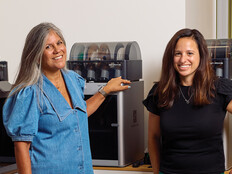Here Is What the Right Tools for Mixed Reality in the Classroom Look Like
In K–12, educators have found ways to use augmented and virtual reality to enhance and support deeper learning in the classroom. However, evaluating the best immersive technology resources requires an understanding of current technology limitations and offerings.
The future looks promising as educational technology companies rapidly build new immersive tools for the classroom.
Conversely, some educators may find that the massive influx of resources makes the selection process confusing. For those teachers, understanding the beneficial characteristics can be a good place to start.
MORE FROM EDTECH: Mixed reality brings new life to the K–12 classroom.
Mixed Reality Classroom Tools Should Capture the ‘Wow’
Teachers who incorporate mixed reality into the classroom will often hear students ask, “How did it do that?” or “Can it do this?” Capturing that “wow factor” is probably one of the most common reasons educators include AR and VR in their lessons.
A physical interactive AR tool — like the MERGE Cube — is a good choice for grabbing your students’ attention. The cube comes to life when using specific MERGE Cube apps, which can be downloaded and used on students’ tablets or phones. Through their devices, students can transform the cube into the Earth, to study weather patterns; the human body, to explore anatomy; a customizable aquarium, to study marine life; and even the solar system.
Ensure K–12 Immersive Lessons Are Device-Agnostic
A common problem with new immersive technology is the platform’s limitations. Most classrooms do not have many high-end AR or VR devices if any.
Considering the typical resources a classroom has, investing in applications that work across common classroom devices is critical. Cross-platform tools will help educators and students effectively implement immersive lesson plans.
When demonstrating VR, I always showcase Nearpod as a simple tool for any educator to include in their instruction.
Many virtual reality lessons include premade, 360-degree images for the students to experience, but Nearpod allows educators to customize their lessons with an enormous library of images that can take their students anywhere imaginable.
After teachers design experience to fit the curriculum, students can participate as a group using their Chromebooks, instead of having to wait one at a time to use the classroom VR headset.
Similarly, there is nothing more frustrating than spending a lot of time creating an exciting, immersive experience and not being able to share it with anyone.
In the Waypoint EDU app, students can explore custom augmented reality scavenger hunts. After teachers create their hunt, they can easily share it by selecting AirDrop to send to nearby devices, or share it by email or text message. This extends immersive content beyond one headset, allowing all students to participate.
MORE FROM EDTECH: 4 ways to make virtual reality integration pay off.
Increase Student Interest Through Content Creation
The beauty of AR and VR is being able to open up possibilities for your students, including creating their own virtual worlds.
I have seen engagement skyrocket when students are given an opportunity to explore AR applications like 3DBear, where they can be the masters of their own digital universe.
At one school, students were placed in small groups and given a device with 3DBear to create content. They enthusiastically placed dinosaurs, robots, animals and other 3D objects around the library. A favorite feature among students was the app’s ability to capture their creations in screen shots and videos.
Provide An Opportunity to Develop Students’ Creativity
The best immersive technology tools should be limited only by students’ imagination. When using augmented and virtual reality, students should be able to decide what is possible.
Using the CoSpaces app, students can easily create virtual worlds regardless of their programming skills. From dragging and dropping premade content onto the screen, to animating and coding using CoBlocks or JavaScript, students can be the creators and work together to produce a fantastic experience.
MORE FROM EDTECH: Maximize your virtual reality classroom integration.
Find Applications That Encourage Collaboration
Immersive technology is advancing, moving away from independent work toward collaborative exercises.
For example, when connected to the same network, students can create experiences in the same virtual space. Among the benefits of group work in augmented and virtual reality: practicing communication, problem solving and building better products.
One example, the Moatboat app, allows students to build spaces together using a content library, directing character animations with typed text or voice commands.
All of these features can serve as a guide to understanding what immersive capabilities are out there, but the most important part of the selection process is defining goals and expectations for how mixed reality integration will benefit classroom instruction.









